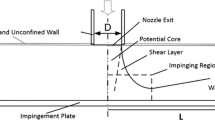Abstract
The characteristic differences in the near wall turbulent structure and the shear stress pattern between a uniform flow and a wall jet with a co-flow stream over a flat surface have been numerically investigated in the present work. A uniform flow of free stream Reynolds number \(Re_{\infty } = 8.64 \times 10^{5}\) is considered to be flowing over a flat plate in one case. Separately, a wall jet with nozzle exit Reynolds number \(Re_{j} = 18000\) along with parallel co-flow stream of Reynolds no \(8.64 \times 10^{5}\) is assumed for the investigation. Realizable \(k - \varepsilon\) model with an enhanced wall treatment scheme has been implemented to capture the near wall features with more details and accuracy. Numerical study reveals that the introduction of turbulent wall jet along with uniform co-flow stream increases the wall shear stress noticeably. The near wall flow structures on introduction of wall jet completely differ from that of the uniform flow. The turbulent fluctuations and the resulting turbulent stress components are found comparatively much higher in case of wall jet.
Access this chapter
Tax calculation will be finalised at checkout
Purchases are for personal use only
Similar content being viewed by others
Abbreviations
- \(u_{\infty }\):
-
Free stream velocity [m/s]
- \(u_{j}\):
-
Jet velocity at nozzle exit [m/s]
- ρ:
-
Density of air [kg/m3]
- ν:
-
Fluid kinematic viscosity [m2/s]
- \(\mu\):
-
Fluid kinematic viscosity [m2 /s]
- w:
-
Nozzle slot thickness [m]
- \(\tau_{{{\text{wx}}}}\):
-
Wall shear stress at location x [Pa]
- \(y_{1/2}\):
-
Wall normal distance where the local stream-wise velocity (u) is half the maximum velocity [m]
- ym:
-
Wall normal distance where the local stream-wise velocity (u) is maximum. [m]
- \(\delta\):
-
Boundary layer thickness for the uniform flow over flat surface.[m]
- \(Re_{j} = \frac{{u_{j} L}}{\nu }\):
-
Jet exit Reynolds number
- \(Re_{\infty } = \frac{{u_{\infty } L}}{\nu }\):
-
Free stream Reynolds number based on plate length L
- \(C_{{{\text{fx}}}} = \frac{{2\tau_{{{\text{wx}}}} }}{{\rho u_{m}^{2} }}\):
-
Local skin friction coefficient
- \(\infty\):
-
Free stream
- j:
-
Jet
- wx:
-
Position along the wall
- m:
-
Maximum value
- t:
-
Turbulent
References
Launder BE, Rodi W (1981) The turbulent wall jet. Prog Aerospace Sci 19:81–128
Eriksson JG, Karlsson RI, Persson J (1998) An experimental study of a two-dimensional plane turbulent wall jet. Exp Fluids 25:50–60
Sigalla A (1958) Measurements of skin friction in a plane turbulent wall jet. J Royal Aeronautical Soc 62:873–877
Dakos T, Verriopoulos CA, Gibson MM (1984) Turbulent flow with heat transfer in plane and curved wall jets. J Fluid Mech 145:339–360
Kline S, Reynolds W, Schraub F, Runstadler P (1967) The structure of turbulent boundary layers. J Fluid Mech 30(4):741–773. https://doi.org/10.1017/S0022112067001740
Gu¨nther A, Papavassiliou DV, Warholic MD, Hanratty TJ (1998) Turbulent flow in a channel at a low reynolds number, experiments in fluids 25(5/6):503–511
Abe H, Kawamura H, Matsuo Y (2001) Direct numerical simulation of a fully developed turbulent channel flow with respect to the reynolds number dependence. ASME J Fluids Eng 123(2):382–393. https://doi.org/10.1115/1.1366680
Roache PJ (1994) Perspective: a method for uniform reporting of grid refinement studies. J Fluids Eng 116(3):405–413. https://doi.org/10.1115/1.2910291
Celik IB, Ghia U, Roache PJ, Freitas CJ, Coleman H, Rand PE (2008) Procedure for estimation and reporting of uncertainty due to discretization in CFD applications. J Fluids Eng 130(7):078001. https://doi.org/10.1115/1.2960953
Baker N, Kelly G, O’Sullivan PD (2019) A grid convergence index study of mesh style effect on the accuracy of the numerical results for an indoor airflow profile. Int J Vent 19(4):300–314. https://doi.org/10.1080/14733315.2019.1667558
ANSYS Inc, ANSYS Fluent Theory Guide 12.0, 2015.
Biswas G, Eswaran V (2002) Turbulent flows-fundamentals, experiments and modelling. Alpha Sci Int Ltd, Pangboume, UK
Author information
Authors and Affiliations
Corresponding author
Editor information
Editors and Affiliations
Rights and permissions
Copyright information
© 2024 The Author(s), under exclusive license to Springer Nature Singapore Pte Ltd.
About this paper
Cite this paper
Nath, P., Patari, A. (2024). The Differences in the Near Wall Turbulent Structure Between a Uniform Flow and a Wall Jet with Co-Flow—A Numerical Study. In: Singh, K.M., Dutta, S., Subudhi, S., Singh, N.K. (eds) Fluid Mechanics and Fluid Power, Volume 2. FMFP 2022. Lecture Notes in Mechanical Engineering. Springer, Singapore. https://doi.org/10.1007/978-981-99-5752-1_23
Download citation
DOI: https://doi.org/10.1007/978-981-99-5752-1_23
Published:
Publisher Name: Springer, Singapore
Print ISBN: 978-981-99-5751-4
Online ISBN: 978-981-99-5752-1
eBook Packages: EngineeringEngineering (R0)




